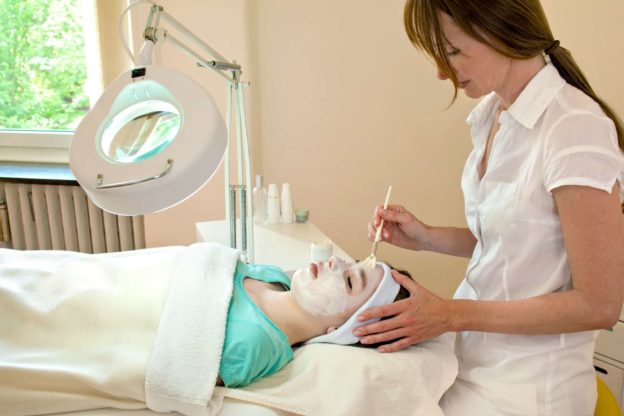Three years ago, Jennifer Aniston talked about how she indulges in chemical peels. But the way she described the process was a bit scary. To paraphrase, she told Conan O’Brien that she looked like a burn victim for a week.
She also mentioned that it was an intense process, with dead skin falling off her face for eight days. Now, if you’ve never had a chemical peel, hearing this could make you have doubts about the thing.
But the truth is, there are different types of chemical peels. Your experience doesn’t have to be as intense as how Aniston described it.
Here, we’ll talk about the main types of chemical peels to help you decide which one is right for you.
Superficial or Light Peels
As the name implies, a light peel is a mild procedure. It uses diluted acids, such as AHAs (alpha hydroxy acids) and BHAs (beta hydroxy acids). Fruit enzymes and other natural acids can be used as well.
This type of chemical peel just sloughs off the epidermis or the topmost layer of the skin. In terms of strength, AHAs like lactic acid and glycolic acid are the mildest. They’re best for treating fine lines, dry skin, mild acne, and hyperpigmentation.
Fun fact: if you ask the pros about their go-to, they will most likely say it’s a glycolic acid peel. That’s because it’s great for a multitude of skin types when used right, of course.
BHAs, on the other hand, are recommended for oily skin types. The most popular BHA is salicylic acid – a common ingredient in a lot of anti-acne facial products.
This ingredient penetrates the skin better than AHAs. But patients who cannot tolerate or are allergic to aspirin shouldn’t use it.
Medium Peels
For a medium depth peel, the gold standard is TCA or trichloroacetic acid. Like light chemical peels, medium peels come in different strengths and combinations.
When used at a lower concentration, it’s often combined with another acid like salicylic acid. But if used alone and at higher concentrations, TCA needs to be administered by a dermatologist.
TCA peels work great for moderate to advanced hyperpigmentation problems, deeper wrinkles, and acne scars. Since this is a stronger acid, a DIY application is not recommended.
Take note that this type of peel may cause inflammation. Your face might look swollen for a week. But once the fresh skin is revealed, you’ll see that it’s brighter and has a better texture.
Deep Peels
When skin peeling involves several layers of the skin, it’s called a deep peel or deep resurfacing peel. To achieve this, your dermatologist will use a phenol or carbolic acid.
Since this is a deep peel, you might need sedation. There are also things you need to do to prep for this procedure. These include staying hydrated, avoiding physical and other chemical exfoliants, and stopping anti-aging or anti-acne medications.
Phenol peels are usually administered only once in a lifetime. It’s a corrective procedure used for severely sun-damaged skin, deep scars and wrinkles, and some pre-cancerous growths.
As this is a very aggressive procedure with a long recovery period, it has to be done in a doctor’s office. Another thing to note about deep peels is that they’re not for everyone.
Patients with darker skin should consider that this type of peel has a bleaching effect. It’s also not the best option for those who have freckles as the end results could be dramatically different and unnatural.
Choosing the Right Type of Chemical Peel
Now that you know the different types of chemical peels, you at least have some idea on what procedure to go for based on your skin’s condition. But as we’ve said before, chemical peels aren’t only for those who have “problem” skin.
Remember, even celebrities who have nearly perfect skin still go for these types of treatment. And if you’re worried about your sensitive skin, you’ll be glad to know that you can still benefit from a chemical peel.
Of course, this doesn’t mean you shouldn’t be careful when it comes to choosing who will administer the procedure. No matter how mild a light peel is, for example, your skin is still being exposed to an acid. That means there’s always a chance of burning when the procedure isn’t done by a qualified professional.
Other things to consider are the downtime and recovery period as well as the costs. If you have a big event coming up, a medium or deep peel may not be the best option.
As for the price, it will depend on where you’re getting it done. Be wary of those clinics or spas that offer super low rates. It’s better to pay more when it comes with the assurance that an expert will perform the peel in a closely monitored environment.
What about Laser Treatments?
If the thought of acids and peeling skin isn’t something you want to consider right now, you could go for laser skin resurfacing treatments. Like chemical peels, they remove the outer layers of the skin, revealing the fresher, younger-looking skin underneath.
Also, when you go in for a consultation, ask about alternatives to chemical peels and lasers. These include microdermabrasion, micro needling, and IPL (intense pulsed light). The more you know about your options, the easier you can make a decision on what type of skin resurfacing treatment to go for.
Want to Know More about the Different Types of Chemical Peels?
A consultation with a skin care therapist or dermatologist will help you understand the different types of chemical peels better. What’s important is to realize that even with the mildest peels, there are possible side effects.
This is why it’s better to let a professional administer the peel. If you’re ever tempted to buy one of those at-home peels, do your research first. Or if you’ve already bought one, don’t forget to patch test beforehand.
For more information on chemical peels and other skin care treatments, don’t hesitate to contact us. Or you may browse our blog to find out more about the latest skincare topics and procedures.


